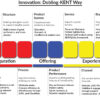
Published in JAMA (August 18, 2025), Shen et al. and the CROWNS-2 Study Investigators
Chronic rhinosinusitis with nasal polyps (CRSwNP) is a chronic inflammatory disease of the nasal passages and sinuses that impacts one to four percent of individuals around the globe. Individuals who are affected by this condition usually experience nasal congestion, loss of sense of smell, rhinorrhea, and facial pressure that decrease quality of life and workplace productivity by a significant amount. China alone sees over 15 million affected individuals with annual healthcare and economic costs of upwards of $11 billion
Traditional therapies for CRSwNP usually start with intranasal corticosteroids, which are to date the first-line therapy. When symptoms are persistent, systematic corticosteroids or endoscopic sinus surgery are usually utilized, although both provide only partial or short-lived benefit to most patients. The last decade witnessed biologic therapies aiming at type 2 inflammatory processes as valuable alternatives. Among those biologics, monoclonal antibodies against interleukin-4 receptor alpha (IL-4Rα) stand out as remarkably effective to decrease polyp size and relieve nasal obstruction
Stapokibart is another monoclonal antibody. While dupilumab, too, targets IL-4Rα but with a different binding epitope, Stapokibart presents possible differences in safety and efficacy. It already proved to have therapeutic effect on atopic dermatitis and seasonal allergic rhinitis. Following promising phase 2 results with CRSwNP, scientists planned the CROWNS-2 study as a large phase 3 randomized clinical trial to examine Stapokibart efficacy and safety among patients with severe, uncontrolled CRSwNP. The milestone study, presented recently in JAMA, is among the most rigorous examinations of Stapokibart to this day
The study included 180 adults at 51 hospitals in China from August 2022 to April 2023. All patients had a high disease burden as indicated by a history of previous sinus surgery or by use of systematic corticosteroids, a bilateral nasal polyp score of at least five on a scale of zero to eight, and moderate to severe nasal congestion at baseline. After a four-week run-in with mometasone furoate nasal spray, patients were randomly assigned to receive Stapokibart or placebo injections every two weeks for 24 weeks with continuation of their intranasal corticosteroids. Participants entered a 28-week open-label period with Stapokibart after the double-blinded period.
The co-primary outcomes of interest were the change from baseline to 24 weeks in nasal polyp score and nasal congestion score; clinically significant end points were set at a one-point decrease in polyp score and a half-point decrease in congestion score. These were accompanied by a wide array of secondary endpoints, such as sinus CT scores, symptom surveys, olfactory testing, quality of life measures, and requirements for rescue therapy with systemic steroids or surgery.
Results were impressive. Patients treated with Stapokibart experienced substantial reduction in nasal polyp size compared with placebo. The reduction at 24 weeks was −2.6 with Stapokibart compared with −0.3 with placebo, which was highly significantly different. Among patients with eosinophilic CRSwNP who tend to have worst disease, benefit was greatest with a reduction of −3.0 compared with −0.4 with placebo. Nasal congestion scores were similarly reduced: Stapokibart reduced congestion by −1.2 points compared with −0.5 with placebo. Notably, benefit was seen as early as week two with polyp size and week four with congestion, demonstrating Stapokibarts rapid onset of action.
Aside from these primary endpoints, Stapokibart significantly enhanced several secondary endpoints. Smell sense markedly enhanced with standardized smell test scores increasing by more than seven points compared to placebo. Loss-of-smell scores reduced significantly, which correlated with substantial recovery of olfactory function. Quality of life, as determined by Sino-Nasal Outcome Test (SNOT-22), became substantially better by more than 23 points, a reduction well below the threshold defining clinical relevance by this scale. Radiologic end-points were equally remarkable with significantly reduced sinus opacification on CT scans. As a group, these data reveal a profile of a therapy that not only reduces burden of disease but returns key lost to disease function, such as breathing and sense of smell, which are central to daily living.
The study also highlighted Stapokibart’s capacity to decrease dependency on rescue therapy. During the double-blind period, none of the patients treated with Stapokibart received systemic corticosteroids or required repeat surgery, as compared to one placebo-treated patient. Clinically, this could equate to fewer cycles of steroid exposure, less surgery burden, and lower incidence of complications due to therapy.
Safety wise, Stapokibart was well tolerated overall. Adverse event rates as a whole were similar to placebo, with the most frequent being mild respiratory infections, such as COVID-19. Two side effects, arthralgia and hyperuricemia, occurred significantly more often with Stapokibart but were not life-threatening. Serious adverse events occurred infrequently, 2.2% for Stapokibart patients versus 1.1% for placebo patients. These data support the drug’s favourable safety profile; nonetheless, caution is advised with patients regarding musculoskeletal symptoms and uric acid levels.
The findings of the CROWNS-2 study are significant. Stapokibart represents an extremely effective add-on therapy for patients with refractory CRSwNP who do not respond adequately to intranasal steroids by itself. Its remarkable efficacy within the subgroup with eosinophilia is especially remarkable since such patients are often the most difficult to treat within otolaryngological practice. Through its reduction of polyp burden, symptom relief for congestion, improvement of sense of smell, and quality of life enhancement, Stapokibart holds much promise to reformat treatment protocols and decrease reliance on systemic corticosteroids and repeat operations.
Ahead lie a number of questions. longer-term studies to examine Stapokibart’s durability at more than one year, as well as its relative effectiveness versus other biologics like dupilumab, are necessary. Cost-effectiveness analyses will play a key role in its accessibility within varying health systems, and other studies might uncover biomarkers that have pre-emptive value to identify patients who stand to benefit most. Nevertheless, CROWNS-2 findings mark an important milestone in treating CRSwNP, joining a growing array of target biologics reshaping chronic airways disease management.
In summary, Stapokibart exhibits exceptional efficacy with tolerable safety among patients with debilitating uncontrolled chronic rhinosinusitis with nasal polyps. Strong evidence for this new therapy is offered by the CROWNS-2 study by Shen Shen and colleagues with the CROWNS-2 Study Investigators. We appreciate with thanks authors and the Journal of the American Medical Association (JAMA) for their crucial role to play in shaping management of this difficult disease.
Dr. Prahlada N.B
MBBS (JJMMC), MS (PGIMER, Chandigarh).
MBA in Healthcare & Hospital Management (BITS, Pilani),
Postgraduate Certificate in Technology Leadership and Innovation (MIT, USA)
Executive Programme in Strategic Management (IIM, Lucknow)
Senior Management Programme in Healthcare Management (IIM, Kozhikode)
Advanced Certificate in AI for Digital Health and Imaging Program (IISc, Bengaluru).
Senior Professor and former Head,
Department of ENT-Head & Neck Surgery, Skull Base Surgery, Cochlear Implant Surgery.
Basaveshwara Medical College & Hospital, Chitradurga, Karnataka, India.
My Vision: I don’t want to be a genius. I want to be a person with a bundle of experience.
My Mission: Help others achieve their life’s objectives in my presence or absence!
My Values: Creating value for others.
References:
Leave a reply
















Leave a reply